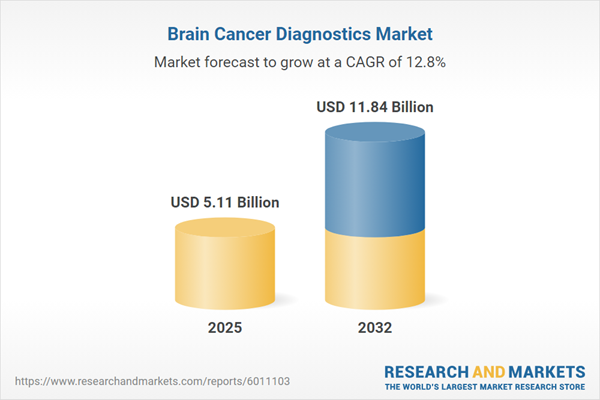Speak directly to the analyst to clarify any post sales queries you may have.
Senior executives in the brain cancer diagnostics market operate in an environment shaped by rapid technological progress, evolving clinical standards, and complex regulatory landscapes. Effective leadership in this sector requires a balance of strategic foresight, operational diligence, and timely adoption of innovations that enhance diagnostic accuracy and organizational efficiency.
Market Snapshot: Brain Cancer Diagnostics Market
In 2024, the global brain cancer diagnostics market is valued at USD 4.52 billion, with expectations to reach USD 5.11 billion by 2025. The projected compound annual growth rate (CAGR) of 12.80% through 2032 reflects strong momentum driven by increased investment in advanced diagnostic systems, modernization of healthcare infrastructure, and supply chain evolution. Innovation in digital imaging platforms and molecular technologies is redefining clinical workflows and provider interactions, while both established and emerging firms are expanding their global presence to meet changing market demands and regional trends.
Scope & Segmentation
This report provides a detailed assessment tailored for executive leaders, outlining the strategic significance of key segments and their influence on procurement, clinical integration, and operational planning:
- Technology: Includes genetic testing, digital imaging modalities such as CT, MRI, PET, next-generation sequencing, PCR-based diagnostics, tissue biopsies, and histopathology—each driving gains in diagnostic precision and more adaptive workflows.
- Product: Consumables, reagents, diagnostic kits, imaging systems, laboratory equipment, technical services, maintenance, and workforce training are central to enabling laboratory excellence and informed procurement.
- Indication: Coverage extends to prominent brain cancer types, such as astrocytoma, glioblastoma multiforme, meningioma, and oligodendroglioma, guiding priorities for product development and research investment.
- Distribution Channel: Analysis of online and offline channels supports insights into market accessibility, continuity in product supply, and the support structure for healthcare providers.
- End User: Segments include diagnostic laboratories, hospitals, and research institutions, each influencing the velocity of technology adoption and clinical innovation worldwide.
- Region: The research evaluates North America, South America, Europe, Middle East & Africa, and Asia-Pacific to identify policy influences, reimbursement adjustments, and preferences that impact expansion and go-to-market strategies.
- Leading Companies: Examines strategies and competitive positioning of major industry players, including General Electric Company, Siemens Healthineers AG, Koninklijke Philips N.V., Canon Medical Systems Corporation, F. Hoffmann-La Roche Ltd., Thermo Fisher Scientific Inc., QIAGEN N.V., Illumina, Inc., Abbott Laboratories, and Agilent Technologies, Inc., highlighting trends in partnerships and market entry.
Key Takeaways for Senior Decision-Makers
- Combining molecular diagnostics and next-generation imaging improves patient assessment processes and supports personalized clinical decision-making across the care journey.
- Formalized collaboration between academic research entities and industry accelerates the translation of scientific breakthroughs into market-ready solutions, enabling proactive adaptation and operational resilience.
- A robust approach to regulatory monitoring helps organizations minimize compliance disruptions, enabling faster product introduction and secure operations across global jurisdictions.
- Broader and more localized sourcing strategies support supply chain durability, enhancing uninterrupted availability of mission-critical diagnostic products as healthcare needs evolve.
- Integration of digital health solutions increases responsiveness to changing oncological requirements and positions organizations to address emerging trends in diagnostic technology and patient care.
Tariff Impact on Brain Cancer Diagnostics
Upcoming import tariffs in 2025 are prompting enterprises to boost domestic production capacity and diversify their supplier base, reinforcing inventory controls and steady access to essential diagnostic technologies. Timely adaptation to new regulatory and distribution frameworks remains essential for business continuity and risk mitigation in the brain cancer diagnostics market.
Methodology & Data Sources
This study leverages a multi-step methodology, synthesizing expert clinical insights, regulatory evaluation, and recent academic research. Every finding undergoes specialist analyst review to ensure it delivers strategically relevant guidance for senior leaders navigating the evolving brain cancer diagnostics landscape.
Why This Report Matters
- Supports executive teams with actionable market intelligence to optimize resource allocation, drive targeted research investments, and refine competitive approaches within the brain cancer diagnostics sector.
- Delivers practical frameworks for navigating regulatory adjustments and complex supply networks, fostering stable operations and minimizing risk exposure.
- Empowers leadership and research teams with granular insights to guide effective adaptation amid rapid developments in diagnostic technology and clinical best practices.
Conclusion
This comprehensive report equips senior decision-makers to proactively manage sector-specific challenges, seize growth opportunities, and pursue sustainable market positioning in the evolving landscape of brain cancer diagnostics.
Additional Product Information:
- Purchase of this report includes 1 year online access with quarterly updates.
- This report can be updated on request. Please contact our Customer Experience team using the Ask a Question widget on our website.
Table of Contents
3. Executive Summary
4. Market Overview
7. Cumulative Impact of Artificial Intelligence 2025
Companies Mentioned
The companies profiled in this Brain Cancer Diagnostics market report include:- General Electric Company
- Siemens Healthineers AG
- Koninklijke Philips N.V.
- Canon Medical Systems Corporation
- F. Hoffmann-La Roche Ltd.
- Thermo Fisher Scientific Inc.
- QIAGEN N.V.
- Illumina, Inc.
- Abbott Laboratories
- Agilent Technologies, Inc.
Table Information
| Report Attribute | Details |
|---|---|
| No. of Pages | 187 |
| Published | October 2025 |
| Forecast Period | 2025 - 2032 |
| Estimated Market Value ( USD | $ 5.11 Billion |
| Forecasted Market Value ( USD | $ 11.84 Billion |
| Compound Annual Growth Rate | 12.8% |
| Regions Covered | Global |
| No. of Companies Mentioned | 11 |









